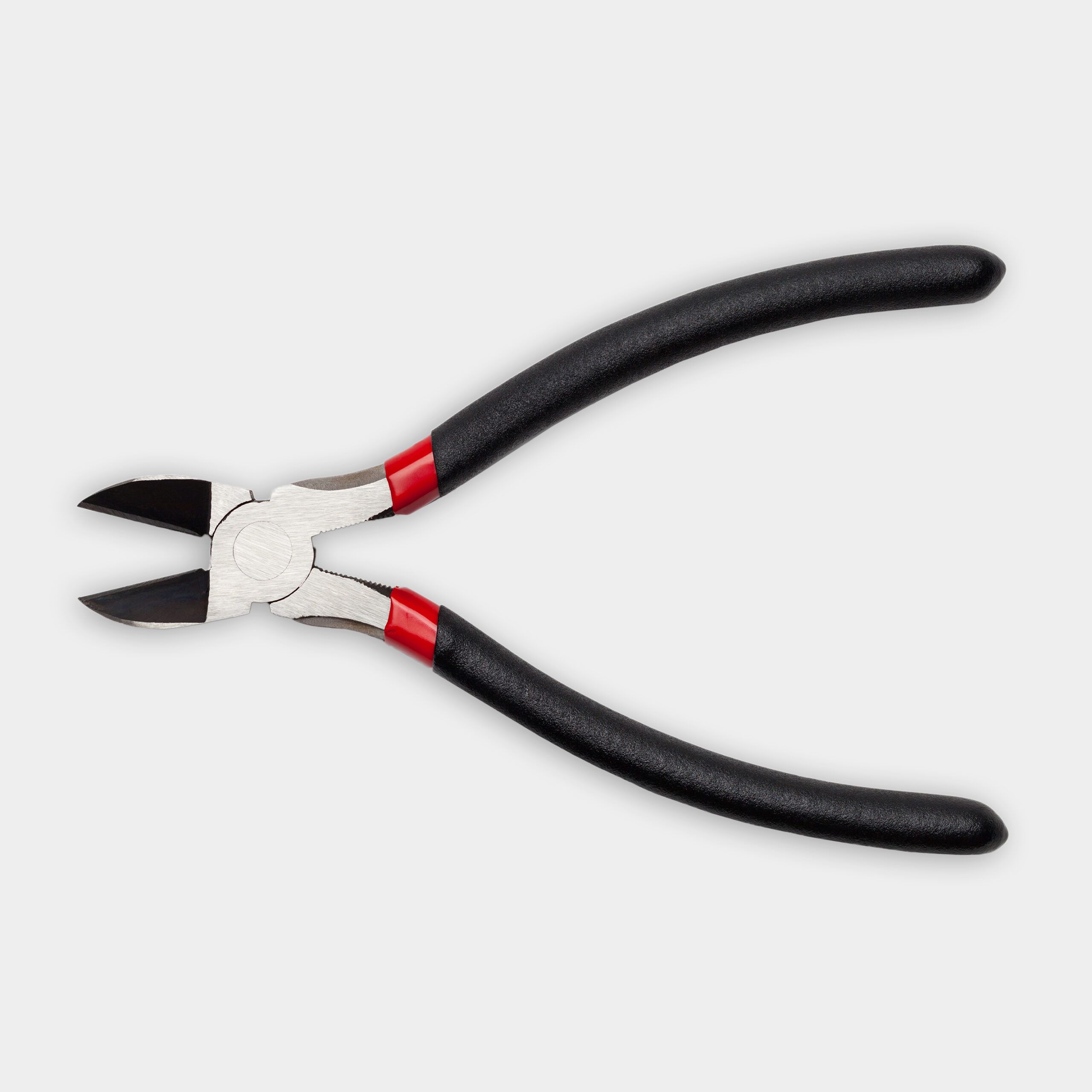We may be compensated if you purchase through links on our website. Our team is committed to delivering honest, objective, and independent reviews on home products and services.
Project details
Skill
Cost
Estimated Time
A decorative grapevine wreath is a simple but rewarding DIY project that can add natural, rustic charm to your home’s exterior. This seasonal craft combines dried flowers and winter fruits and berries to make a unique decoration that can last throughout the colder months. In this video, Flower Girl NYC owner and founder Denise Porcaro demonstrates how to create a beautiful and winter-ready grapevine wreath using various natural materials.
Step 1: Gather Materials for Your Wreath
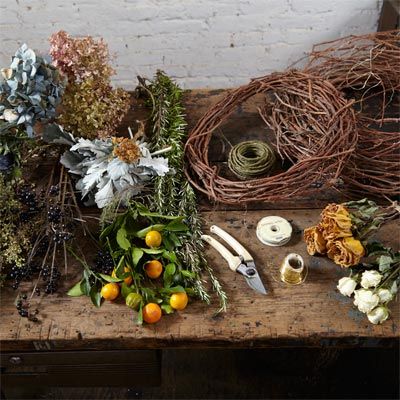
While you can find most of these materials at a craft store or purchase them from a florist, you can also source many of them from your backyard.
Selecting the Base
Your wreath’s foundation will impact its overall structure and appearance, so you’ll want to choose strong, weather-resistant vines. Here are your two main options:
- Loose-dried grapevines: You can purchase these from a florist. Loose-dried grapevines allow for a more customized wreath size and shape.
- Premade grapevine wreath forms: Available at most hobby stores and online retailers, these are convenient starting points for your project and can save you time.
Choosing Decorative Elements
A grapevine wreath’s beauty lies in its natural, seasonal appearance, so consider your home’s style and the atmosphere you want to convey when choosing the decorations and details. You have many decorative elements to choose from, including the following:
- Berries: Bittersweet and black elderberries add pops of color.
- Dried flowers: Hydrangeas, thistles, and other sturdy blooms work well.
- Greenery: Eucalyptus provides a lovely contrast and fragrance.
- Winter fruit: Kumquats or other small citrus fruits offer a bright, unexpected touch.
Find the Right Tools
Once you select your materials, make sure you have the following tools to work on your wreath:
- Bypass pruning shears: For cutting stems and vines
- Floral wire: To secure elements to the wreath base
- Wire cutters: For trimming floral wire
Step 2: Make the Wreath Base

First, you need to form the base. Work carefully and pay attention to the details so your base is strong and the decorative elements don’t slip out.
Forming the Circular Shape
If you’re using loose grapevines, follow these steps:
- Begin by gently twisting the vines into a circular shape, following their natural curve.
- As you form the circle, tuck the ends of any wayward vines into the other vines to secure them.
- Continue twisting and tucking until you’ve created a sturdy, circular base.
If you’re using a premade form, skip this step and move directly to decorating.
Tips for a Solid Base
- Aim for a consistent thickness throughout the wreath.
- Gently bend and reshape the wreath as needed before adding decorations.
- Keep the circle as symmetrical as possible for a balanced appearance.
Step 3: Add Decorative Elements to Your Wreath
Now that you’ve prepared your base, it’s time to add decorative elements to bring your wreath to life. As you style your wreath, aim to balance all the components for a cohesive but natural look.
Add Berries and Eucalyptus
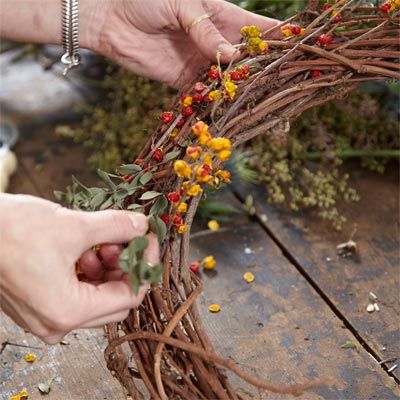
Start by weaving in the larger pieces of decor—like large berry stems and branches—following these steps:
- Cut bittersweet berry stems, leaving 2–3 inches exposed.
- Carefully insert the stems into the grapevine base, tucking loose ends out of sight into the wreath.
- Follow with eucalyptus branches, placing the stems among the vines and tying them to the wreath with floral wire as needed.
Layer Flowers and Accents
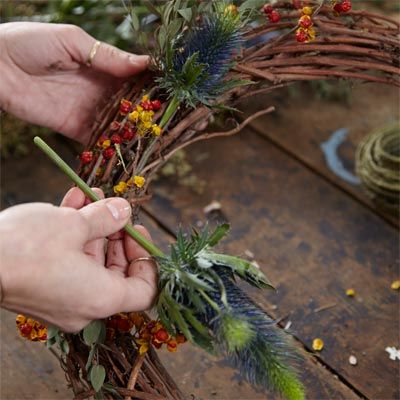
Next, add the floral decorations and other accents to your wreath. Consider these tips:
- Concentrate the flowers on one side of the wreath for an asymmetrical, natural look.
- Incorporate elderberries throughout the floral arrangement for additional texture and color.
- Place thistle flowers over the eucalyptus, using wire to tie them to the vine form.
Weave in Dried Flowers
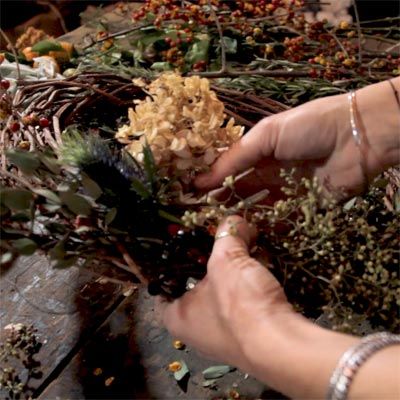
Dried hydrangeas add volume and a soft texture to your wreath. After gently securing larger blooms with wire if necessary, gently work the hydrangea blooms into your arrangement. Be careful when handling these delicate flowers to prevent crumbling.
Step 4: Add the Finishing Touches
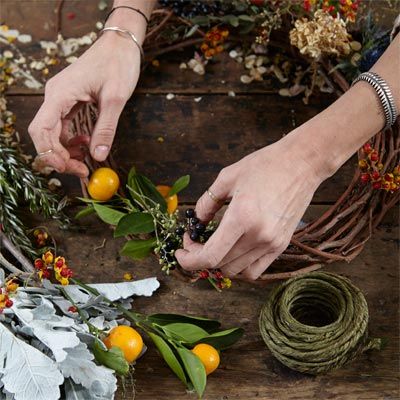
Kumquats or other small citrus fruits provide a bright, seasonal flair and make a nice final touch. Keep the following tips in mind when adding these fruits to your wreath:
- Place some fruits on the main decorated area and a few on the opposite side for balance.
- Securely attach the fruits to prevent them from falling off.
- Wire the stems of a few kumquats and tuck them into the wreath.
Wreath Styling Tips
As you put your wreath together, here are some design and placement tips to help you get the most out of your decor:
Balancing the Design
- Add or remove elements as needed to achieve your desired look.
- Consider the placement of colors and textures so they blend well together.
- Step back and assess your wreath from a distance to check that the overall design is what you envisioned.
Securing All Elements
- Double-check that you’ve firmly attached all components to the base.
- Trim any visible wire ends for a neat appearance.
- Use additional wire to secure any loose items to the vine.
Displaying Your Wreath
- Choose a location that showcases your wreath without exposing it to harsh elements.
- Consider hanging it on a door, above a mantel, or in a prominent window.
- If you hang it outdoors, choose a protected area so your wreath lasts the whole season.
Taking Care of Your Wreath
Follow these maintenance tips to keep your wreath looking fresh throughout the year.
Replacing Decorations
- Consider swapping out certain elements seasonally for a refreshed look.
- Replace any dried flowers or fruits that may have fallen off or sustained damage.
- Stock up on the decorative features you like during their peak seasons for future wreath projects.
Routine Care
- If hung outdoors, bring your wreath inside during severe weather.
- Keep it away from direct sunlight and heat sources to prevent fading and drying.
- Periodically—and gently—dust your wreath with a soft brush or cloth.
Creative Variations
While this grapevine wreath template results in a stunning creation on its own, try following some of these suggestions to experiment with the design for a unique twist:
Alternative Greenery and Flowers
Different types of greenery and flowers can transform your wreath’s aesthetic. Consider the following:
- Lavender: Lavender produces a calming scent and a touch of purple.
- Rosemary: Rosemary offers a fragrant option that pairs well with many other elements.
- Sunflowers: Sunflowers invoke summer tones and add a bright, cheerful look.
Theme-Specific Wreaths
You can adapt your wreath for different seasons or occasions as follows:
- Harvest: Add corn husks, small pumpkins, and autumn leaves for a fall-inspired wreath.
- Holiday: Incorporate miniature ornaments, ribbons, and holiday-themed florals for a festive touch.
- Spring: Use pastel-colored flowers, faux bird’s nests, and small eggs for a springtime feel.
Unique Additions
Adding nontraditional accents can give your wreath an unusual but charming flair. Try incorporating the following:
- Feathers: Feathers add softness and a natural look.
- Ribbon and fabric strips: These strips add color and texture, and you can mix different materials for a layered effect.
- Twigs and pinecones: These natural elements provide an earthy, rustic feel.
Our Conclusion
A DIY grapevine wreath can spruce up your home and create a warm, welcoming atmosphere even in winter. You can use any decorative elements you want to make your wreath, from flowers and fruits to berries and herbs. Using a few simple tools and some creativity, you can adapt your homemade wreath for any holiday or season.

